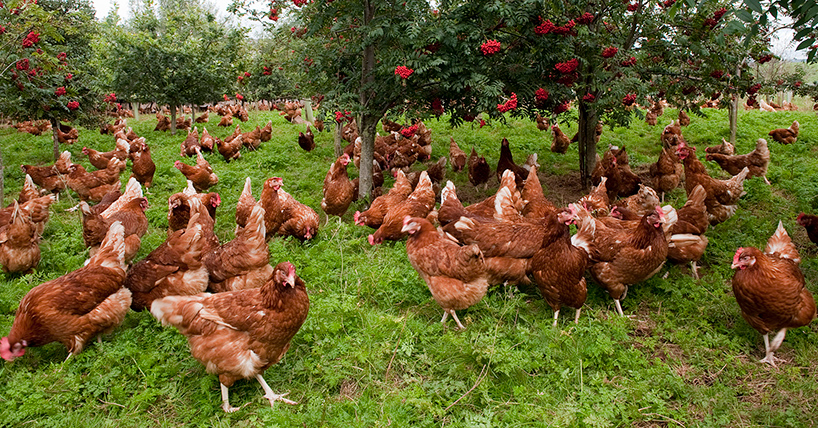Chicken Stress
Improving the welfare of laying hens by understanding their brains
Published on: 4 October 2019
A multi-million European-wide project to improve the conditions of egg-laying chickens is launched today, to coincide with World Animal Day.
The ChickenStress European Training Network (ETN) is bringing together 20 partners in education and industry, including Hendrix Genetics and Vencomatic, two major suppliers to the global egg industry. It will train future leaders in a range of scientific studies and help egg producers attain the best possible welfare standards for chickens.
It has received €3.9 million investment from the EU Marie Curie Fund.
Dr Tom Smulders, Reader in Evolutionary Neuroscience from Newcastle University, UK is leading the project. He explains: “Shoppers consistently ask for chickens to be kept in the highest possible welfare conditions and in Europe in 2012 this led to a ban on battery cages. However, while this was introduced with the best of intentions with an eye to improving welfare, unexpected problems have occurred with alternative productions systems.”
Over the course of four years, 14 international studies under the supervision of world experts in their fields will be carried out on factors which contribute to stress response and resilience in poultry. Involving industry partners, these will range from examining what causes stress in chickens from the breeding to how they are raised to the environment they are kept in – including the feed systems and housing.
Dr Smulders explained: “We still don’t know what is best for laying hens in these large-group housing systems and it is difficult to ask the chickens. We will study how stress affects the brain and use this knowledge to identify best practice. We don’t know, for example, how the environment in which they are reared affects how well they adapt to the free-range systems they will be housed in in adulthood, nor how hatching conditions affect their ability to deal with novel situations later in life. These are the kind of welfare questions we want to answer with this project.”

Measuring stress responses and responsivity
A variety of methods will be used over the course of the projects to measure stress responses and responsivity in laying hens, including markers in the brain (neurogenesis, different neurotransmitters), stress hormones, behavioural tests and observations, and health parameters.
Each project will involve a PhD student as part of the initiative to develop future scientific leaders. By working with industrial partners including Hendrix Genetics, Vencomatic, Noldus Information Technology and The Lakes Free Range Egg Co Ltd, as well as the European Union of Wholesale with Eggs, Egg Products, Poultry and Game, the scientific team will be able to implement conditions that maximise welfare and productivity.
The ChickenStress European Training Network involves; Newcastle University, UK, Institut de Recerca Biomèdica de Lleida - Fundació Dr. Pifarré (IRBLleida), Universidad de Lleida, The University of St Andrews, The Open University of Israel, Universitaet Bern, Scotland’s Rural College, Universiteit Utrecht, Norwegian University of Life Sciences, Eigen Vermogen -Instituut voor Landbouw en Visserijonderzoek, Hendrix Genetics, Trinity College Dublin, Vencomatic Group BV, Noldus Information Technology BV, Max Planck Institute for Ornithology, University of Veterinary Medicine, Vienna, Linköpings Universitet, The Lakes Free Range Co. Ltd., Universiteit Gent and Tel Aviv University.

Latest News
Heading 3 example
Text only. For subheading use ‘Heading 3’
Lorem ipsum dolor sit amet, consectetur adipiscing elit. Donec vel sapien lectus. Aliquam consectetur vitae tortor mattis sodales. Donec id quam id nulla tristique vestibulum. Ut vitae orci aliquam massa varius dapibus. Vivamus aliquet, lorem sit amet semper ultricies, ex tortor molestie felis, at ultrices tellus ligula vitae est. Sed gravida tortor sapien, in iaculis quam vestibulum vel. Duis et quam nec metus pharetra placerat. Donec in tellus pretium ex sagittis posuere. Nunc varius, libero at suscipit commodo, magna lacus facilisis velit, sed pellentesque magna eros vel dolor. Donec pretium neque ultrices, condimentum turpis non, porttitor neque. Suspendisse fermentum at lectus scelerisque mattis. Nam augue justo, iaculis quis euismod et, viverra in elit. Aliquam vitae justo malesuada, sodales urna et, aliquam nunc. Nulla placerat neque quis odio molestie, mattis bibendum turpis pellentesque.



